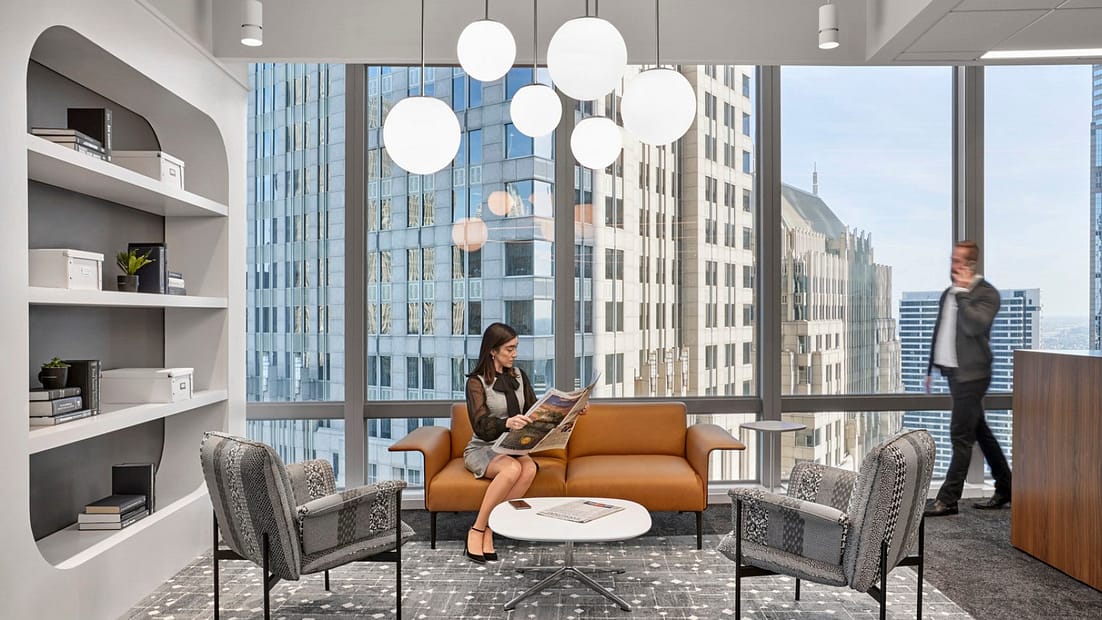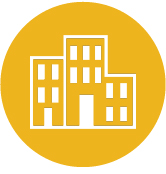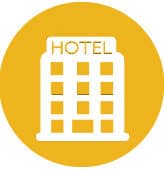TOGETHER AT WORK

Photography © Garrett Rowland.
By Erin Meyers, NCIDQ, LEED GA | Senior Designer
and
Danele Spoden, NCIDQ | Designer
In the blink of an eye, our working lives have temporarily relocated from office to home. As highly connected agents of change, we challenge ourselves to be inquisitive and reevaluate the next state of work. With the world in recovery, the workplace is in need of restoration: to rejuvenate and remake itself holistically.
Work environments of yesterday offered a “work from anywhere” agile mentality. Places like the office, home, co-working spaces, the third place (coffee shop, hotel, etc.), and transit (airports, etc.) catered to a range of work styles and settings. A large portion of employees chose to work in the office; some decided to work remotely, and there was limited overlap. The work environments of tomorrow will continue to support the same settings with a renewed mentality. The new work week will likely evolve. For example, two-to-three workdays remote for concentration, with one-to-two workdays at the office for collaboration could be the new norm, allowing a balanced integration of in-office work and remote work. Office occupancy will also likely shift to enable choice: offices could see a one-to-one ratio, where every employee is assigned a personal space, or an autonomous option wherein an increase in space sharing gives employees a choice in where and how to work.
Work Environments of Yesterday

Office
A palette of places that supports both focus & collaborative work allowing individuals to interact in person and virtually in a controlled environment.

Home
69% of employers offer remote work on an ad hoc basis to at least some employees, 42% offer it part time, 27% offer it full time.

Co-Working
A 24/7 flexible office environment with on-demand meeting rooms, resources, and an emphasis on creating community.

Third Space
31% of full-time employees in the United States do most of their work away from their employers' locations.

In-transit
Business travel accounts for about 12% of airline passengers, which means airport terminals have become a "third space."
Workplace design will evolve with a healthcare lens, including wellbeing programs, individual controls, and materiality that protects against the spread of infection. The virtual office environment will support advances in technology and provide the seamless, inclusive access across all platforms in the digital sphere. The four main workplace space types (individual, meeting, community, support) will be altered to address six priorities in the workplace: sanitation, technology, MEP systems, materiality, sustainability, and wellbeing. Together, these elements will help create welcoming, safe environments for individuals, enabling them to do their best work.
Work Environments of Tomorrow
Workplace
The workplace of tomorrow will offer a range of environments and choices.

One-to-One Ratio
Every employee will be assigned to a space.

Autonomous
Choice of where and when to work.

A Healthcare Lens
Designers will look to healthcare as an example for materiality, technology, sanitation protocols, etc.

How do we increase the efficiency of sanitation?
Encourage personal hygiene, practice respiratory etiquette, expand the frequency of sanitation and disinfection, and roll-out cleaning protocols.

How can technology improve everyday user experience?
Incorporate automatic, voice, or touch-less interfaces, consider non-invasive contact tracing, increase telepresence capabilities, and encourage telemedicine practice.

How can MEP systems support the new workday?
Increase ventilation and filtration, balance humidity levels between 40%-60%, and integrate anti-microbial LED lighting for high-traffic areas.

How can materiality affect the built environment?
Make materials work harder. Source anti-microbial metals, coatings for textiles, non-porous and bleach-cleanable wovens, and easy-clean or self-cleaning surfaces. Teams should be able to select materials that are safe for the employees and the environment.

How do we maintain sustainability?
Challenge each project to design to a standard, consider video conferencing to reduce the carbon footprint from transportation, embrace life cycle thinking, encourage movement and activity, and retrofit existing space to make them more energy-efficient and healthier.

How do we design offices that nurture wellbeing?
Increase in-office programming that supports the whole person, install behavioral signage for legibility and wayfinding, foster a shift in culture, humanize the workplace by designing for performance and biophilia.


